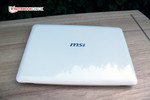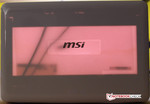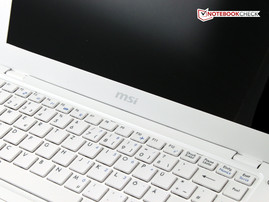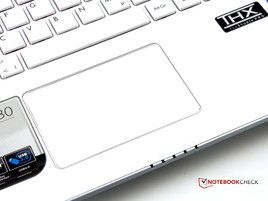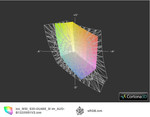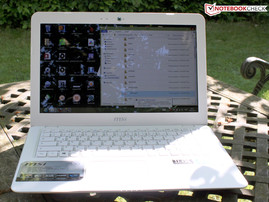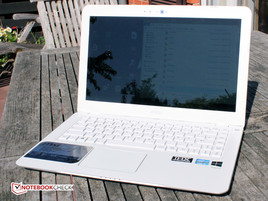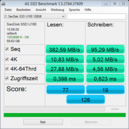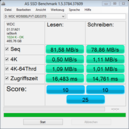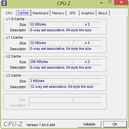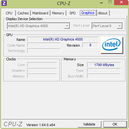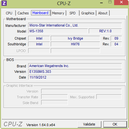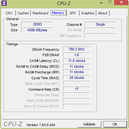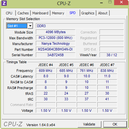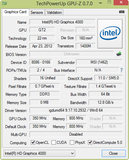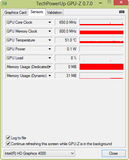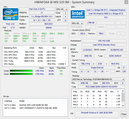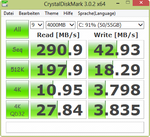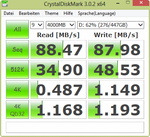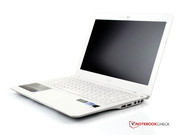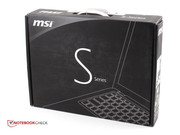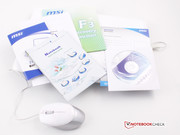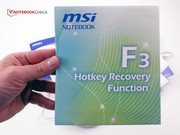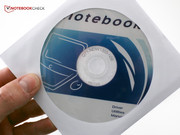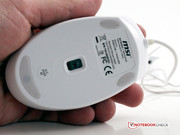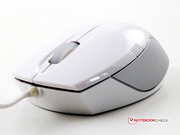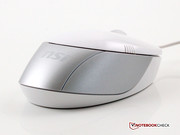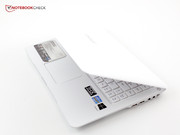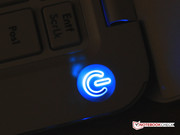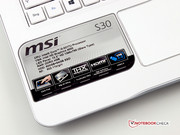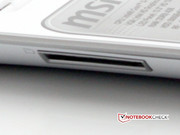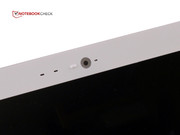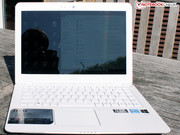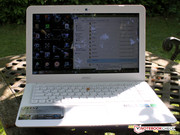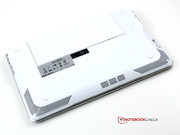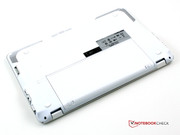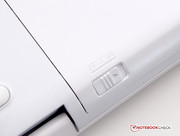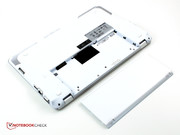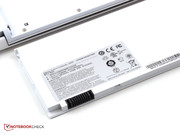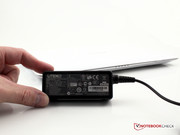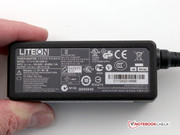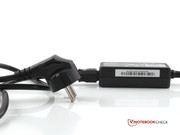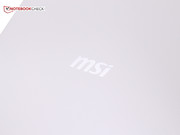Review MSI S30-i3U465 Slim Notebook

For the original German review, see here.
MSI expands it S-series laptop product line with two slim models. The S20-i541 UltraSlider ultrabook, which is a two-in-one device (ultrabook and tablet PC), and the S30-i3U465 Slim. We introduced the former in another test report. This review is to test the subnotebook's everyday suitability. To compare the quality and performance, we used the AMD based Samsung 535U4C, the Intel based Asus VivoBook S300CA, the Acer Aspire S3-391 and, as a somewhat higher quality model, the AMD based Asus VivoBook U38DT.
Case
The S30-i3U465 is not the slimmest of its kind at 22.8 millimeters. All the contenders are thinner. Acer's Aspire S3-391-53314G52add is the slimmest at only 17.5 millimeters. However, our test device does a better job in weight. It is in second place with 1400 grams, right after the 1360 grams of Acer's Aspire S3-391. Samsung's Series 5 535U4C weighs the most with 1840 grams. That is a difference of 31%.
The subnotebook's casing is made of glossy white plastic. The lid features a chic pattern of small, light gray circles. MSI's logo in the center is highlighted in silver. The lid yields under pressure and warps easily. The material is so thin that it shines through from the inside in the dark and the innards, so the screen and cables become visible.
Two hinges firmly connect the display lid to the lower part. It cannot be opened with one hand. However, the display wobbles when opened. This prevents working properly on even slightly shaky surfaces.
The wrist rest, display bezel and keyboard rim are comprised of matte white plastic. However, the keyboard inlay is made of high-gloss white plastic. The subnotebook's bottom is also white and features a hinted metal-like effect. A plastic silver border separates the top and bottom.
The S30-i3U465's bottom part generally makes a better build impression than the display lid. The wrist rest yields marginally on the right. This area is nevertheless stiff enough to carry the opened subnotebook in one hand. The area left of the touchpad is more pliable. The keyboard also gives away under pressure. This yielding is greatest toward the center.
A lot of stickers have been adhered to the wrist rest. A large silver sticker with specifications about the subnotebook's hardware and software almost covers the entire free surface. Perhaps it is to block the waste heat a bit, which is discharged to the front directly beneath that and thus prevent an unpleasant warming on the wrist rest.
The included power supply unit features an agreeable, compact size with a height of just 25 millimeters, a length of 88 millimeters and a width of 35 millimeters. Unfortunately, the two-pin grounded plug is unwieldy in comparison.
Connectivity
There are not particularly many interfaces although they are within the standard scope for a subnotebook. The back left sports the ports for VGA, Gigabit LAN and HDMI. The plugs have enough room. The front left also harbors the card reader for SDHC, SD, SDXC and MMC cards. Regrettably, it has been placed so low that the cards can only be inserted when the subnotebook is tilted a bit. The USB 2.0 and USB 3.0 port, microphone, headphone and power socket are cramped on the right. There is only enough room for small plugs should all the ports be needed. At least there is enough elbowroom for right-handed users when the included mouse is used. MSI's S30-i3U465 does not have an optical drive. Only Samsung's 535U4C can score with an optical drive, which is reflected in the weight of 1840 grams.
Communication
In addition to Bluetooth 4.0, MSI's S30 also supports Wi-Fi 802.11 b/g/n by means of Intel's Centrino Wireless-N 135 and Gigabit LAN via Realtek's PCIe GBE Family Controller. The Wi-Fi modules' reception was excellent at a distance of three meters. It was still good in the upper story (10 m) and outdoors at 15 m and satisfactory at 40 m.
MSI touts the webcam installed in the display's bezel as an HD web camera featuring "smooth video broadcast" and specifies a resolution of 1280x800 pixels at 30 fps (frames per second). In contrast to many webcams, the resolution is really supposed to be in the area of the promised pixels. The test proved that the webcam installed in the test device actually provided the promised resolution. Thus, even small details can be captured in the picture or shown to a video-partner via the webcam. Unfortunately, the poor color reproduction narrows this good impression. The picture has a heavy bluish cast and pictures sometimes look overexposed.
Software
MSI preinstalls Windows 8 on its S30-i30U465. There is also a recovery version on the subnotebook. It can be used for resetting the device to state of delivery or repairing the system by pressing the F3 key while booting. Besides that, several apps are pre-installed, e.g. Skype or Music Make Jam from Magix.
Accessories
In addition to the usual accessories, such as a quick start guide and warranty specifications, the S30-i30U465 comes with a driver CD, user's manual and a collection of programs as well as an optical mouse that can be connected to the subnotebook via USB 2.0. The CD cannot be used without an optical drive and has to be copied first from another computer or external drive (not included) onto a USB stick or a memory card. An SD card containing this data would have made more sense.
Maintenance
It is not possible for "normal" users to upgrade the memory or replace the hard drive. According to MSI's manual, an authorized dealer or customer care advisor should be consulted. The fan cannot be accessed for cleaning purposes either.
Warranty
MSI includes a two year manufacturer's warranty with pick-up & return service on its laptops ex-factory. It can be upgraded to three years for 139 Euros (~$184) on MSI's webpage.
Input Devices
Keyboard
The keyboard in the S30 is a standard, chiclet-style unit with 103 keys and no number pad. The keys are slightly curved horizontally and have a matte surface. The drop is quite short. The keyboard can be described as pleasant due to its accurate pressure point and quiet click noise. We favorably noticed that no keys are extremely small. The arrow keys feature the same size as the letter keys with 14 x 14 millimeters. Only the function keys are somewhat narrower with 14 x 10 millimeters, but that does not have a negative effect.
Touchpad
The touchpad does not have dedicated mouse keys and MSI sells this as the latest innovation. This design is also known as Clickpad. The pad is lowered into the wrist rest and separated by a silver rim. Its surface is lightly roughened and allows the fingers to glide agreeably over it. The gained space created by the omitted mouse keys cannot compensate for their absence. Users who are accustomed to feeling the difference between the left and right mouse keys will have difficulties distinguishing this on the S30-i3U465. The touchpad accepts clicks over its entire surface. Right clicking needs quite a bit of effort. The pad acknowledges clicks with a loud feedback. Finger gestures were implemented accurately and even slight gestures were accepted. Left clicks can also be implemented by lightly tapping on the touchpad. It is difficult to use the right mouse key without moving the cursor. Fortunately, an additional mouse is included. Thus, it is possible to deal with tasks and play games that require two mouse keys. Acer's Aspire S3-391 also uses a Clickpad.
Display
MSI installs a 13.3-inch glare screen with a native resolution of 1366x768 pixels in its S30-i3U465. To be precise, it is the B133XW01V2 panel. MSI does not offer other screen models for our test device. The brightness can be set in eleven levels ranging from a maximum of 246 cd/m² to almost complete darkness. Its average brightness is 221 cd/m². The brightness is sufficient for indoor use. The illumination of only 78% lags approximately 10% behind the contenders and it could also have been more homogeneous.
| |||||||||||||||||||||||||
Brightness Distribution: 78 %
Center on Battery: 136 cd/m²
Contrast: 444:1 (Black: 0.5 cd/m²)
44.57% AdobeRGB 1998 (Argyll 3D)
64% sRGB (Argyll 3D)
43.46% Display P3 (Argyll 3D)
The picture makes a high-contrast and focused impression. With a black value of 0.5 cd/m² and contrast ratio of 444:1, MSI's S30-i3U465 clearly has the lead on the contenders from Samsung and Acer. Samsung's 535U4C only achieves a black value of 2.21 cd/m² and contrast of 151:1. The Aspire S3-391's rates are just as middling with a black value of 1.91 cd/m² and contrast of 551:1. The screen in Asus' VivoBook S300CA subnotebook is clearly in the lead and reaches an impressive black value of 0.35 cd/m² at a contrast of 611:1.
As is common for screens from this price range, the color space cannot be satisfied in comparison with the sRGB reference color spectrum. It clearly drifts into blue. The color accuracy is not sufficient for professional image editing. However, the color reproduction is adequate for normal users who deal with office applications, videos and games.
The viewing angles of our test device are very tight. The contrast deteriorates massively when the vertical or horizontal angle is altered and the picture looks unfocused and overexposed. The colors invert in larger horizontal changes. Looking at pictures or vacation videos with others is not really possible.
Performance
MSI only has the S30-i3U465 Slim available in the configuration present. It sports an Intel Core i3 processor from the third generation alongside the processor-integrated Intel HD Graphics 4000. MSI advertises the S30 as a multimedia subnotebook for daily use on the go and at home.
Processor
MSI installs an ultra-low voltage dual-core processor in our S30 test device. Intel's Core i3-3217U is used. As expected, the i3's performance is lower than that of the i5. Thus, the test results of Acer's Aspire S3-391-53314G52add are much better because it is powered by Intel's Core i5-3317U. However, in the Cinebench R11.5 test our test device achieved the same scores as the Asus VivoBook S300CA contender, which also sports a Core i3-3214U. Asus' VivoBook U38DT (AMD A8-4555M) and Samsung's Series 5 535U4C (AMD A6-4455M) lag behind our test device by 50%.
The temperature management works well for the installed CPU. The waste heat was successfully discharged so that throttling did not occur. The CPU's 1795 MHz also remained stable in the stress test during full load via Furmark and Prime95.
The CPU's performance was also available without significant losses in battery mode without the PSU.
| Cinebench R11.5 - CPU Multi 64Bit (sort by value) | |
| MSI S30-i3U465 Slim | |
| Asus VivoBook S300CA | |
| Acer Aspire S3-391-53314G52add | |
| Samsung 535U4C | |
| Asus VivoBook U38DT-R3001H | |
| Cinebench R10 - Rendering Single CPUs 64Bit (sort by value) | |
| MSI S30-i3U465 Slim | |
| Asus VivoBook S300CA | |
| Acer Aspire S3-391-53314G52add | |
| Samsung 535U4C | |
| Asus VivoBook U38DT-R3001H | |
System Performance
Windows 8 runs swiftly on the MSI subjectively. Not even 8 seconds pass from turning on the laptop until the start screen appears. Waking up from standby is also swift with 2 seconds. Programs that are installed on the SSD load fast and process data very smoothly. The use of an SSD (solid state drive) as the primary hard drive for the operating system and frequently used applications fully shows its advantage. This is also reflected in the scores of our PCMark 7 and PCMark Vantage benchmarks. The competition is left standing. However, the drawback is that the user has to take care to install programs on the right partition. The 64 GB SSD is soon filled and then even simple driver updates could be a farce. The "custom" option has to be checked for every installation in order to set the right partition. However, when frequently used programs and their caching are stored on the SSD users will be more than pleased about the speed that MSI's S30-i3U465 exhibits.
| PCMark Vantage Result | 7565 points | |
| PCMark 7 Score | 3340 points | |
Help | ||
Storage Devices
A U100 SSD from SanDisk with a nominal capacity of 64 GB is installed in our test device. Fortunately, only 600 MB is reserved for one of the recovery partitions. The remaining 18 GB for the recovery partitions is on the second conventional hard drive. That is a 500 GB Western Digital WD5000LPVT from the WD Scorpio Blue series. Thus, the user effectively has over 550 real GB available for the operating system, programs and data.
Although the SanDisk offers a considerable speed advantage over conventional hard drives in terms of access time, it is exactly these access times that are not awe-inspiring in the category comparison. The U100 SSD 64 GB needs 0.4 milliseconds for read and over 0.6 milliseconds for write access. Good rates would be 0.1 milliseconds for read and at most 0.3 milliseconds for write access. The rates in random read and write of 4K blocks are even more astonishing. Almost 11 MB/s in read and only 3.7 MB/s are achieved in write. The write rates are thus at the lower end of the performance scale.
The WD5000LPVT spins at 5400 revolutions per minute and shows good read access times with 17.3 milliseconds as well as decent data rates with 87.3 MB/s. Interestingly, the competition does not use superior HDDs. Thus, our test device can score throughout in the field of storage devices.
Acer's Aspire S3-391 features a 20 GB SSD cache besides the HDD.
Graphics Card
MSI relies on the processor-integrated Intel HD Graphics 4000 for its S30-i3U465 Slim subnotebook. With a default clock of 350 MHz and a Turbo Boost of up to 950 MHz, this graphics card does not feature a dedicated memory and shares it with the processor.
The scores in the latest 3DMark benchmark did not disclose any surprises. Our test device is on a par with other HD Graphics 4000 configurations with 554 points in 3DMark 11. The core clock of 950 MHz is maintained as long as the graphics card's temperature does not exceed 70 °C in Turbo Boost. However, these high temperatures were only reached during extreme load in our stress tests or in the Cinebench benchmarks. The HD Graphics 4000's maximum possible core clock of 1050 (in the i3-3217U according to Intel) was never achieved and 950 MHz was never surpassed.
Contenders that also feature a processor-integrated graphics card like our test device achieve similar scores. These would be Asus' VivoBook S300CA and Acer's Aspire S3-391-53314G52add. Samsung's Series 5 535U4C can score considerably with its dual-card solution after a driver update to Catalyst version 12.8. It achieves 1159 points in 3DMark 11 because the integrated AMD Radeon HD 7500G and the dedicated AMD Radeon HD 7550M share tasks. The dual-card solution in Asus' VivoBook U38DT does the best job. 1242 points is achieved in 3DMark 11 with its dedicated Radeon HD 8550M. It is possible to select the integrated Radeon HD 7600G for more basic tasks. To what degree the advantage in 3DMark 11 affects the gaming performance can be read in our gaming benchmark further below.
MSI's subnotebook can use its full graphics power in battery mode without the PSU. It also keeps the Turbo Boost upright for a longer time because the high temperatures produced by the CPU are not reached as quickly.
| 3DMark 06 Standard Score | 4291 points | |
| 3DMark 11 Performance | 554 points | |
| 3DMark Ice Storm Standard Score | 27566 points | |
| 3DMark Cloud Gate Standard Score | 2950 points | |
| 3DMark Fire Strike Score | 416 points | |
Help | ||
| 3DMark 06 - 1280x1024 Standard Score AA:0x AF:0x (sort by value) | |
| MSI S30-i3U465 Slim | |
| Asus VivoBook S300CA | |
| Acer Aspire S3-391-53314G52add | |
| Samsung 535U4C | |
| Asus VivoBook U38DT-R3001H | |
Gaming Performance
Downright gaming entertainment cannot be expected from an integrated Intel HD Graphics 4000 graphics card. Only games with a similar demand on the graphics card as FIFA 13 can be played in high resolutions. The Asus VivoBook U38DT and Samsung Series 5 535U4C can reproduce a few extra frames per second with the dedicated graphics card. Games like Counter Strike: GO or Anno 2070 can only be rendered in low graphics resolutions. Consequently, gamers will not experience real gaming fun.
| low | med. | high | ultra | |
|---|---|---|---|---|
| Anno 2070 (2011) | 35 | 17.65 | 11.8 | |
| Counter-Strike: GO (2012) | 55.3 | 35.53 | 21.33 | |
| Fifa 13 (2012) | 67.2 | 55.3 | 34.81 |
Emissions
System Noise
MSI's S30-i3U465 Slim can be called quiet in idle mode. Only a quiet clacking from the HDD is occasionally heard when it starts to spin. The fan is enabled right after the CPU and / or GPU is demanded. It reaches a noise level of 44 decibels in heavy load, for example, when playing some games or video editing.
Noise level
| Idle |
| 31 / 31 / 32.5 dB(A) |
| HDD |
| 31.2 dB(A) |
| Load |
| 34.7 / 44 dB(A) |
 | ||
30 dB silent 40 dB(A) audible 50 dB(A) loud |
||
min: | ||
Temperature
The S30 always remains cool in routine office use. It is even possible to use it on the lap as long as the fan is not spinning. However, hot air blows on the left thigh when the fan is enabled due to a higher performance demand. The fan reaches a maximum of 39.7 °C then, which is very unpleasant over a longer time. Regrettably, MSI opted for a waste air outlet toward the lower left front in its subnotebook. The fact that the wrist rest mostly has a pleasant temperature and does not exceed 33.4 °C does not compensate for that either. It is not possible to use the device on the thighs for a long time for demanding work or conversations, which load the CPU and / or GPU, e.g. watching videos on YouTube. That is actually not a good selling point for a subnotebook.
(+) The maximum temperature on the upper side is 34.2 °C / 94 F, compared to the average of 35.9 °C / 97 F, ranging from 21.4 to 59 °C for the class Subnotebook.
(+) The bottom heats up to a maximum of 39.7 °C / 103 F, compared to the average of 39.3 °C / 103 F
(+) In idle usage, the average temperature for the upper side is 22.7 °C / 73 F, compared to the device average of 30.8 °C / 87 F.
(+) The palmrests and touchpad are reaching skin temperature as a maximum (34.2 °C / 93.6 F) and are therefore not hot.
(-) The average temperature of the palmrest area of similar devices was 28.2 °C / 82.8 F (-6 °C / -10.8 F).
Speakers
We have gotten used to the fact that the sound from subnotebook and laptop speakers do not awe with great depth. However, we were surprised that the speakers in MSI's S30 test device render such a flat sound. The sound from our test device is characterized by extreme trebles, flat mids and virtually no bass. In view of the unsatisfactory sound, the fairly low volume is no problem. Consequently, headphones or a stereo system should be used for a decent sound experience.
Energy Management
Power Consumption
The power consumption is generally very exemplary. Only 0.1 watts is consumed in a deactivated state and 0.2 watts in standby. Samsung's Series 5 535U4C and Asus' VivoBook S300CA need 0.5 watts and 0.4 watts respectively, in standby. Our S30-i3U465 is also modest when idling and consumes a consistent maximum of 10.7 watts. A maximum of 27.1 watts is used during load. Consequently, the 39.9 watt power supply provided enough energy for all work scenarios.
| Off / Standby | |
| Idle | |
| Load |
|
Key:
min: | |
Battery Runtime
According to MSI's website, the S30 has a maximum runtime of 10 hours. It wholeheartedly acclaims that the battery runtime will last for a whole day on the road. However, it looks different in real life. The battery lasted for just 5 hours in our Battery Eater's Reader's test with minimum screen brightness and disabled Wi-Fi. The battery still lasted for 3 hours and 13 minutes in an everyday scenario where the subnotebook only had little work, such as internet browsing via our Wi-Fi test. This is far from enough for a whole day away from the desk. The battery is too weak for a long movie. It did not last for more than 1 hour and 33 minutes. We cannot explain how this difference to the 10 hours of runtime specified by MSI and the 5 hours that we achieved evolve. The screen brightness can be reduced one level, which we did, but then it is de facto dark and nothing can be recognized.
The 32 watt hour battery is too small to really last a whole day. The 2 hours and 25 minutes needed for recharging is not exactly short either.
Samsung's Series 5 535U4C and Asus' VivoBook S300CA achieve a runtime of 4 hours and 30 minutes in the Wi-Fi test. The other contenders last for not quite 4 hours.
Verdict
MSI's S30-i3U465 Slim could be quite enticing as a swift laptop. It looks chic, clad completely in white and it is not too heavy with a weight of 1400 grams. Unfortunately, exceptionally high-quality materials were not used so that the display lid even lets light shine through the panel. Another drawback is that the fan outlet blows out the waste heat from the lower left front at almost 40 °C. This restricts the time for working with the subnotebook on the lap.
We particularly deem that the basically high mobility of the compact 13-incher is primarily limited by the short battery runtime and the screen's low brightness in battery mode. Buyers who are willing to spend a few hundred Euros more will find a top-notch built laptop in Asus' VivoBook U38DT. However, compromises have to be made with the CPU and hard drive.




